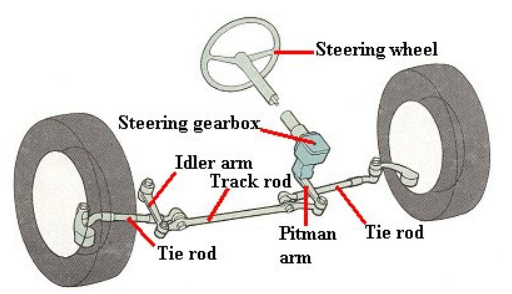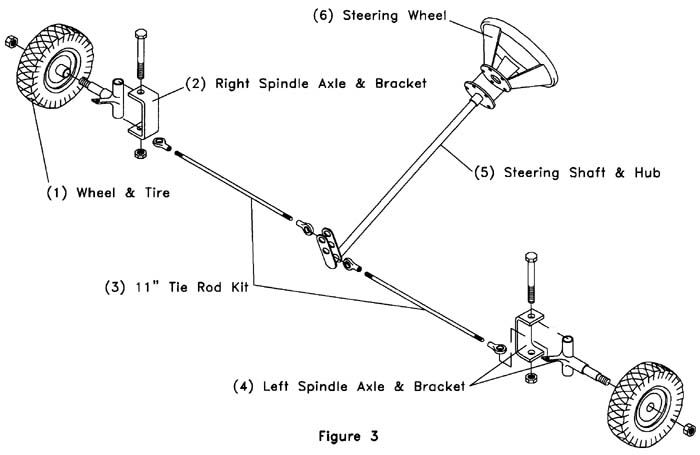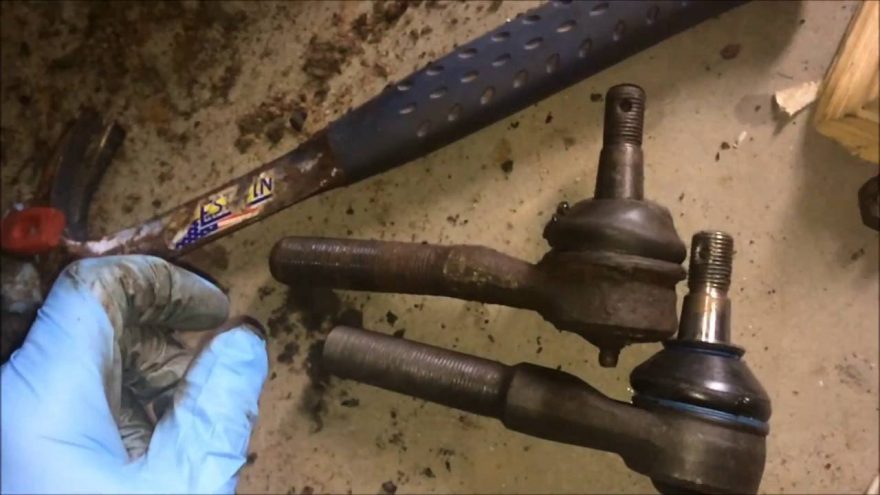Tie rods are a crucial part of your ATV's steering system, so it pays to recognize and look for the signs of failure and know how to change or upgrade ATV tie rods.
A failing ATV tie rod can interfere with your ability to steer, causing tires to pull in one direction or another, the steering wheel may shake at higher speeds, and the steering may feel loose. This is irritating, and it makes it more difficult to control the vehicle which could lead to accident.
You may lose the ability to steer at all if your tie rod fails.
Image from www.atvillustrated.com
If the potential for losing the ability to steer isn't bad enough, driving with bad tie rods can also cause early or uneven tire wear.
There may be many ways to discover your ATV is bad.
You may notice:
Off-road are the core piece of riding gear for ATV & UTV riders
Find out the best look for you
This is an easy job that doesn't require and special equipment or tools, so you can definitely do it yourself.
Things you'll need:
Tie rods are made up of three main parts, the tie rod itself and tie rod ends. The ends thread on and have nuts to lock them in. You adjust the length of them by threading and securing the tie ends.
Aftermarket tie rods come disassembled with all the parts you'll need. They should come with instructions, and assembling them is easy.
The one issue you may run into is confusion about the threads of the tie rod ends. The two ends thread in different directions. This is intentional. Follow the threading and don't try to force them to do something different or assume they're bad.
Jack up your ATV securely on jack stands and remove your tires.
You'll see the closest end of the tie rod positioned just above the A-arm.
You could take photos of the tie rod, including the ends behind the wheel hub and under the steering stem, before you remove them so you have no doubt how to reinstall them.
Remove the cotter pin holding the closest end of the tie rod in place, then loosen the nut. When you try to loosen the nut, it may also spin the tie rod end. If so, you'll need a wrench to hold the tie rod still while you turn the nut.
Repeat the last two steps on the other end of the tie rod.
Hold the old and new tie rods beside each other and determine if the ends are equally tightened. You want the length from the end of the tie rod to the tip of the tie rod ends to be the same on both the old and new parts. This is an easy way to judge if your new tie rod will fit.
There is a notch on the tie rod that indicates which direction the tie rod should be facing. The notch should be on the wheel side.
If you don't remember where the tie rods were, slip the tie rod under the A-arm and connect it in the first hole under the steering stem, then put the closest end of the tie rod in the hole behind the wheel hub.
Fit the new washer and nut where the tie rod sticks out of the hole, but don't tighten them all the way.
Do the same to the side closest to the inside of the machine.
Put your wheels back on and check the alignment. You may need to further tweak the fit of the tie rod and realign the tires.
When you are sure the tie rods are in place, fully tighten the nuts and add the cotter pins. You can bend the cotter pins around the nuts for added protection.
There would be nothing wrong with you upgrading your stock tie rods anytime you choose. Aftermarket tie rods are thicker and more durable than stock tie rods, so you can prevent potential issues this way.
If you already have tie rod wear or damage, you could feasibly reshape a bent tie rod, but it will weaken it, so it won't be a long-lasting repair. Rusted or worn tie rods need to be replaced.
If only one of your tie rods is bad, you could replace only the one, but since you'll be upgrading when you replace it, why not go ahead and replace both so you have two new and improved tie rods?
HIT
ENDURO LIGHT Graphite
the most durable
458 EUR
HIT
ENDURO Camogrey
the most durable
657 EUR
ENDURO Graphite
the most durable
279 EUR
HIT
ENDURO Graphite
the most durable
657 EUR
-28%
AQUAMASTER-ZIP LIGHT Camogrey
with central zipper
598 EUR
430. 40 EUR
40 EUR
HIT
ENDURO LIGHT Camogrey
the most durable
458 EUR
-12%
AQUAMASTER LIGHT Red
reliability & comfort
438 EUR
386.20 EUR
NEODRY Black
NEOPRENE SOCKS
17 EUR
11.90 EUR
ENDURO Camogrey
the most durable
279 EUR
AQUAMASTER Blue
reliability & comfort
647 EUR
-20%
HIT
AQUAMASTER Red
reliability & comfort
259 EUR
207.20 EUR
-40%
HIT
AQUAMASTER Orange
reliability & comfort
259 EUR
155.40 EUR
AQUAMASTER Red
reliability & comfort
677 EUR
ENDURO BF Camogrey
bootfoot waders
528 EUR
ALL SEASON Black
HIGH-ACTIVITY THERMAL UNDERWEAR
69 EUR
ENDURO BF Camogrey
bootfoot waders
329 EUR
MUDWAY Graphite
RELIABLE JACKET
179 EUR
MUDWAY Camogrey
RELIABLE JACKET
179 EUR
NEOSENSOR Camoarmy
SEMI FINGERLESS GLOVES
12 EUR
8. 40 EUR
40 EUR
MUDWAY Red
RELIABLE JACKET
179 EUR
Explore all
Select a country
United States | Canada | Germany | Lithuania | Latvia | Estonia
Afghanistan
Albania
Algeria
Andorra
Angola
Anguilla
Antarctica
Antigua and Barbuda
Argentina
Armenia
Aruba
Australia
Austria
Azerbaijan
show more
Bahamas
Bahrain
Bangladesh
Barbados
Belarus
Belgium
Belize
Benin
Bermuda
Bhutan
Bolivia
Bosnia and Herzegowina
Botswana
Bouvet Island
Brazil
British Indian Ocean Territory
British Virgin Islands
Brunei Darussalam
Bulgaria
Burkina Faso
Burundi
show more
Cambodia
Cameroon
Canada
Cape Verde
Cayman Islands
Central African Republic
Chad
Chile
China
Christmas Island
Cocos Islands
Colombia
Comoros
Congo
Cook Islands
Costa Rica
Cote D'ivoire
Croatia
Cuba
Cyprus
Czechia
show more
Denmark
Djibouti
Dominica
Dominican Republic
East Timor
Ecuador
Egypt
El Salvador
Equatorial Guinea
Eritrea
Estonia
Ethiopia
show more
Faeroe Islands
Falkland Islands
Fiji
Finland
France
French Antarctic
French Guiana
French Polynesia
show more
Gabon
Gambia
Georgia
Germany
Ghana
Gibraltar
Greece
Greenland
Grenada
Guadeloupe
Guatemala
Guinea
Guinea-bissau
Guyana
show more
Haiti
Heard and McDonald Islands
Honduras
Hong Kong
Hungary
Iceland
India
Indonesia
Iran
Iraq
Ireland
Israel
Italy
show more
Jamaica
Japan
Jordan
Kazakhstan
Kenya
Kiribati
Korea (North)
Korea (South)
Kuwait
Kyrgyzstan
show more
Laos
Latvia
Lebanon
Lesotho
Liberia
Libya
Liechtenstein
Lithuania
Luxembourg
show more
Macau
Macedonia
Madagascar
Malawi
Malaysia
Maldives
Mali
Malta
Marshall Islands
Martinique
Mauritania
Mauritius
Mayotte
Mexico
Micronesia
Moldova
Monaco
Mongolia
Montenegro
Montserrat
Morocco
Mozambique
Myanmar
show more
Namibia
Nauru
Nepal
Netherlands
Netherlands Antilles
New Caledonia
New Zealand
Nicaragua
Niger
Nigeria
Niue
Norfolk Island
Norway
show more
Pakistan
Palau
Palestine
Panama
Papua New Guinea
Paraguay
Peru
Philippines
Pitcairn Islands
Poland
Portugal
Puerto Rico
show more
Reunion
Romania
Russia
Rwanda
Saint Helena
Saint Kitts and Nevis
Saint Lucia
Saint Vincent and the Grenadines
Saint-Pierre and Miquelon
Samoa
San Marino
Saudi Arabia
Senegal
Serbia
Seychelles
Sierra Leone
Singapore
Slovakia
Slovenia
Solomon Islands
Somalia
South African Republic
South Georgia and the South Sandwich Islands
Spain
Sri Lanka
Sudan
Suriname
Svalbard and Jan Mayen Islands
Swaziland
Sweden
Switzerland
Syria
show more
Taiwan
Tajikistan
Tanzania
Thailand
Togo
Tokelau
Tonga
Trinidad and Tobago
Tunisia
Turkey
Turkmenistan
Turks Caicos Islands
Tuvalu
show more
U. S. Virgin Islands
S. Virgin Islands
United States
Uganda
Ukraine
United Arab Emirates
United Kingdom
Uruguay
Uzbekistan
show more
Vanuatu
Vatican City
Venezuela
Viet Nam
Wallis and Futuna Islands
Western Sahara
Zaire
Zambia
Zimbabwe
{{#DETAIL_PAGE_URL}} {{SECTION_NAME}} {{NAME}} {{/DETAIL_PAGE_URL}}
Color: {{COLOR}}
{{#IS_SIZE}} Size: {{{SIZE}}} {{/IS_SIZE}}
Quantity:
Only {{AVAILABLE_QUANTITY}} left
{{#SHOW_DISCOUNT_PRICE}}
{{{SUM_FULL_PRICE_FORMATED}}}
{{/SHOW_DISCOUNT_PRICE}}
{{{SUM_PRICE_FORMATED}}}
{{/GIFT}} {{#GIFT}}
{{/GIFT}} {{/EMPTY_BASKET}} {{#EMPTY_BASKET}}
Your basket is empty
{{/EMPTY_BASKET}}
{{/FREE_SHIPPING}} {{#FREE_SHIPPING}}Free shipping available
{{/FREE_SHIPPING}}{{^FREE_SHIPPING}}
{{{FREE_SHIPPING_PERCENT}}}%
{{/FREE_SHIPPING}}
{{{FREE_SHIPPING_PRICE}}}
CHECKOUT {{{PRICE_FORMATED}}}
{{/EMPTY_BASKET}} {{#EMPTY_BASKET}} {{/EMPTY_BASKET}}Continue shopping
Your cart:
Your basket is empty
 And to a large extent, they determine how the ATV will handle, overcome obstacles and deliver comfort from the ride. Just like tires, shock absorbers come in different types and are matched to different types of road and off-road. Our workshop installs shock absorbers only from proven and reliable manufacturers who have proven their products not only in the Russian market, but also internationally.
And to a large extent, they determine how the ATV will handle, overcome obstacles and deliver comfort from the ride. Just like tires, shock absorbers come in different types and are matched to different types of road and off-road. Our workshop installs shock absorbers only from proven and reliable manufacturers who have proven their products not only in the Russian market, but also internationally.
 Change or repair, it's up to you, but we believe that safety comes first and should not be saved on this. Turning to us for help in choosing ball joints, you may be pleasantly surprised that you can purchase and replace original ball joints on an ATV in our workshop for almost the same money that you would spend on their repair.
Change or repair, it's up to you, but we believe that safety comes first and should not be saved on this. Turning to us for help in choosing ball joints, you may be pleasantly surprised that you can purchase and replace original ball joints on an ATV in our workshop for almost the same money that you would spend on their repair.

Leave a request for service
 If this is neglected, then you will end up with uneven wear of the rubber. We would like to draw your attention to the fact that on some ATVs the camber is not adjustable and is set by the manufacturer. Our masters have developed a unique method for adjusting the camber - convergence of ATVs, so by contacting us you will receive qualified assistance in adjusting.
If this is neglected, then you will end up with uneven wear of the rubber. We would like to draw your attention to the fact that on some ATVs the camber is not adjustable and is set by the manufacturer. Our masters have developed a unique method for adjusting the camber - convergence of ATVs, so by contacting us you will receive qualified assistance in adjusting.
 You can get advice or sign up for an oil change by calling the QUADMASTER service.
You can get advice or sign up for an oil change by calling the QUADMASTER service. The requirements for the serviceability of the steering system are strictly established by the SDA. According to the rules, the operation of a car with faulty steering is not allowed - after all, such a car creates a considerable danger to other road users. This is the main reason why regular replacement of steering tips is necessary - to ensure the safety of both the driver of the car and other people.
Steering tips provide not only the mobility of the entire steering mechanism, but also allow you to set the desired angle of rotation of the wheels. In short, the steering system consists of several elements:

It is the steering tips that account for numerous shock loads that occur when driving on uneven surfaces: shallow pits, gravel, railway crossings. Taking on most of the load, the tips thus protect the steering rods and the rack itself from mechanical influences, significantly increasing their service life.
All this leads to the failure of the tips, which causes a malfunction of the steering, which must be eliminated in a timely manner.
It is quite simple to identify this malfunction: when driving on a rough road, a knock will be clearly heard in the front of the car, which also occurs during sudden acceleration or braking. In addition, the steering wheel play appears, the car will noticeably lose controllability, it will begin to “float” along the road.
You can also check the integrity of the steering tips by jacking up the car and rocking the wheel from side to side - if the movement of the wheel is quite noticeable, then the steering tip must be changed.
Untimely replacement leads not only to a decrease in the controllability of the car, but can also cause other malfunctions: wheel alignment will be disturbed, as a result of which the car will “steer” to the side when driving in a straight line and uneven wear of the rubber will occur;
The moment when it becomes necessary to replace defective steering tips is much closer with the following features of driving a car:
It is also worth periodically inspecting the condition of the anthers of the steering tips - their damage entails the ingress of dirt into the swivel joint, which significantly reduces the quality of lubrication.
Tips are consumable items and should be replaced every 40-50 thousand kilometers. Depending on the quality of spare parts, it is often necessary to change them much earlier than scheduled maintenance, especially for domestically produced cars.
Replacement of VAZ steering tips is often required every 15-20 thousand kilometers, but the frequency of work largely depends on the manufacturer of spare parts. On some car models (for example, Hummer), repairable steering tips are installed, but their restoration requires considerable experience, so only professionals should be trusted with such work.
Important! Replace steering tips only in pairs - they cannot be replaced on one side only. As practice shows, they fail almost simultaneously.
To replace the steering tip, you need not only a set of keys, but also a special puller, with which the tip can be easily separated from the hub. In the absence of a puller, many owners simply slightly loosen the nut that secures the tip to the hub, and knock out the tip with sharp, strong hammer blows. However, there is a risk of overshooting and damaging other suspension components, or even the car body.
However, there is a risk of overshooting and damaging other suspension components, or even the car body.
When replacing the tie rod end, proceed as follows:
The only difficulty that motorists often face is the souring of the nut and the tip itself in the hub, as a result of which it becomes quite problematic to remove it.
It should be remembered that the steering tips are responsible for the alignment of the front wheels, and when replacing them, a mandatory adjustment is necessary. It is impossible to perform it on your own without special equipment, and all attempts to establish the camber “by eye”, counting the number of revolutions by which the old tip was screwed into the rod, are not accurate. In addition, in the manufacture of each part, there is some error in size, sufficient for a serious violation of the wheel alignment angle.
It is impossible to perform it on your own without special equipment, and all attempts to establish the camber “by eye”, counting the number of revolutions by which the old tip was screwed into the rod, are not accurate. In addition, in the manufacture of each part, there is some error in size, sufficient for a serious violation of the wheel alignment angle.
It is better to entrust the check and replacement of the tips to the service station specialists, who will immediately after the replacement check and correct the alignment of the wheels. In addition, the installation of tips on some brands of cars is associated with some nuances that only specialists can know.
Uremont.com service will help you find a service station that repairs and diagnoses your car's suspension. With us, any maintenance will become fast, high-quality and affordable for the motorist.
How does Uremont work?
01
Create an application
with a brief description of the work and the desired repair date.